Mexican State Capitols: Zacatecas, Zacatecas
Visited: August 31. 2019
To get to Zacatecas, we took off very early on the road to from Saltillo to Zacatecas. Sharing the road with lots of big trucks, that were very polite and always pulled over to let another car pass. As we drove down the road we found that both our stomachs and our gas tank were getting empty so stopped at a gas station. At the gas station there were various stalls set up selling breakfast. Looking around we picked the one that looked the busiest and sat on a little plastic stool. I asked the guy what he was selling and he said 4 tacos and orange juice for $40 pesos (about $2US). Sounded like a bargain to me, so there we ate breakfast at a gas station. The service was simple but the sunrise over the mountains was a nice view.
 What is now known as Zacatecas got it’s start in 1531 when the Spanish conquerors expanded Jalisco by creating a settlement called Nochistlan. In 1541 the Caxcans, the local indigenous group, had enough of Spanish conquering and rebelled by killing a Spanish leader called Miguel de Ibarra. The Spanish were not going to allow that, so they called on some help from the Tlaxacalans (an ally indigenous group) and they purged the Caxcans from the entire area. What little Caxcans that survived fled and joined the Chichimecas, which got their revenge by raiding silver caravans in Nuevo Leon.
What is now known as Zacatecas got it’s start in 1531 when the Spanish conquerors expanded Jalisco by creating a settlement called Nochistlan. In 1541 the Caxcans, the local indigenous group, had enough of Spanish conquering and rebelled by killing a Spanish leader called Miguel de Ibarra. The Spanish were not going to allow that, so they called on some help from the Tlaxacalans (an ally indigenous group) and they purged the Caxcans from the entire area. What little Caxcans that survived fled and joined the Chichimecas, which got their revenge by raiding silver caravans in Nuevo Leon.
In 1546, the capital city of Zacatecas officially founded by Juan de Tolosa, Cristobal de Onate, and Pedro Almendez Chirinos. They did this to secure the rights to one of the biggest discoveries ever of silver. The silver in the area was a big deal, by the 18th century, the state was producing 1/5th of all the silver in the world.
During this growth period of 300 years, the Jesuits came an established the Catholic church in 1558 in Zacatecas. In 1593 they started the Convent of San Francisco, which was during the Spanish period a sort of city center. The convent saw a lot of action during the Mexican Independence when Miguel Hidalgo’s troops marched through Zacatecas twice. Once while attacking the Spanish army and once while running away from the Spanish army. Mexico did gain it’s independence in 1821, but Zacatecas did not recognize the newly formed Mexican Empire, it was not until Mexico became a Republic did Zacatecas recognize the Mexican government and became a state in 1824.
Mexico in the 19th-20th century was a crazy place to be. In 1859 Liberal leader Jesus Gonzalez Ortega took control of the state of Zacatecas and basically kicked out the Catholic priests by seizing all their land. To which the conservatives responded by taking all the money and creating the state of Aguascalientes. Then in 1861 French troops came in and took over Zacatecas, but that only lasted two years, the local joke is they didn’t like French food. The fight for the silver never really ended and just got worse in the early 20th century during the Mexican Revolution. One of the biggest battles of the Mexican Revolution called the Toma de Zacatecas. This battle involved Fransisco (aka Pancho) Villa and nationalist troops lead by Victoriano Huerta. Over 7,000 soldiers died and another 5,000 were injured.
Two hundred years of battles exhausted the state of Zacatecas. With all the fight, fought out of the state the city of Zacatecas today has grown into a humble but proud colonial city. Thanks to it’s Spanish roots, going into the old city center you will rubble along cobblestone roads and find the remains of the old convent. The Government Palace sits adjacent to the cathedral, the two form a L shaped plaza. The old Jesuit monastery is still mostly in ruins, but has been converted into a little park and museum, where you can see a big collection of masks and old puppets.
While we were in Zacatecas we just by happenstance came in during La Morisma. La Morisma is a festival that celebrates St. John the Baptist and St. James. It is said to be one of the oldest festivals in Mexico. It is a reenactment of sorts where the people dress up as the Moors and Spanish soldiers and parade through the streets, then they meet up at the outskirts of town and recreate the battle where the Spanish ousted the Moors from Spain in the late 1400s. This festival takes place on the last weekend of every August and involves more that 12,000 participants.
Video:

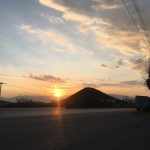

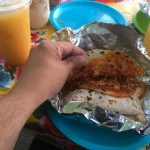






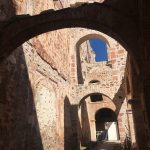


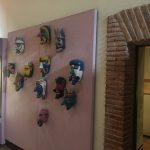


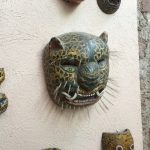





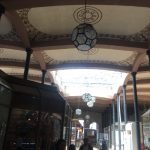


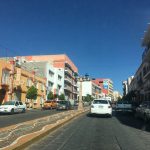


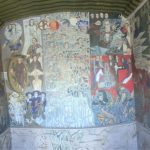






Those are CRAZY costumes, and 12,000 participants? WOW. This must also be the place that inspired Bob to buy the jaguar mask he brought home.
That is where I bought the jaguar mask. I love your descriptions. I otherwise have very little to go on name-wise because the Spanish doesn’t stick with me. I would really like to go back to Zacatecus. Beautiful town, very distinct and different.